High Level Summary of Statistics: Key Trends for Scotland 2006
Presents key trends for Scotland across all areas of governement activity.
6. School Education
Pupils
Pupil Numbers
In 2005 there were 713,240 pupils in publicly funded schools. The number has fallen from 763,539 in 1997. The latest projections suggest a further 13% fall in pupil numbers by 2016. There were a further 30,321 pupils in independent schools, which equates to 4% of school pupils.
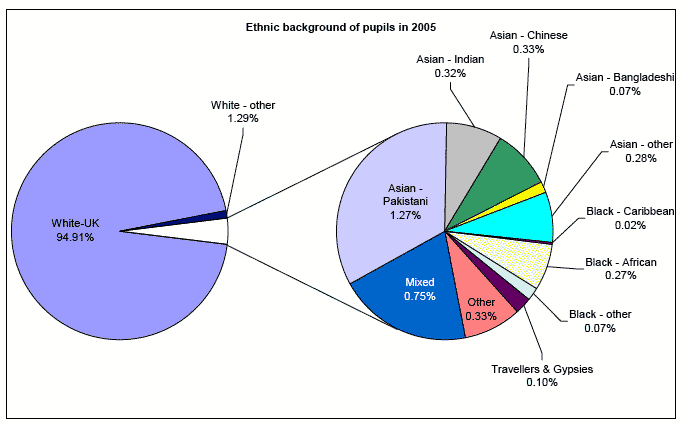
Source: School Pupil Census
Publications
Pupils in Scotland, 2005 (Published 2006)
Independent School Census, April 2006 (Published 2006)
Pupil Projections 2005 (Published 2005)
Education out with Schools
There were 544 children known to be educated at home due to parental choice. It is recognised however that more such children may be home educated, but are not currently in contact with their local authority.
Publication
Children Educated Outwith Schools, 2004/05 (Published 2005)
Pupil Attainment
Pupil Attainment S4-S6
The percentage of pupils gaining 5 or more Standard Grades at credit level (or equivalent) by the end of S6 increased from 38% in 1998/99 to 47% in 2002/03 and has since remained constant. However, there have only been modest improvements in S4 over the last 5 years.
More than nine out of ten pupils gained a Standard Grade (or equivalent) in both English and Maths in 2004/05; this has been consistent over a number of years.
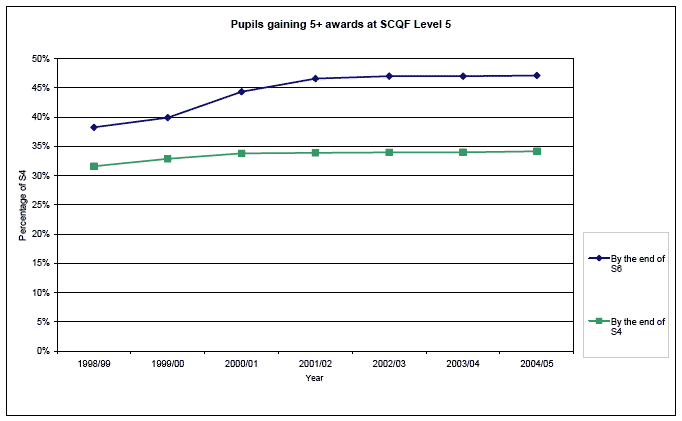
Source: Scottish Executive Education Statistics
Average Tariff Scores of S4 pupils
Attainment of the lowest performing 20% of pupils in S4 had remained constant in recent years but dropped slightly in 2004/05. Meanwhile, attainment of all S4 pupils gradually increased, until 2004/05 when it then flattened.
Increasing the average tariff score of the lowest attaining 20% of S4 pupils by 5% by 2008 is one of the Closing the Opportunity Gap targets.
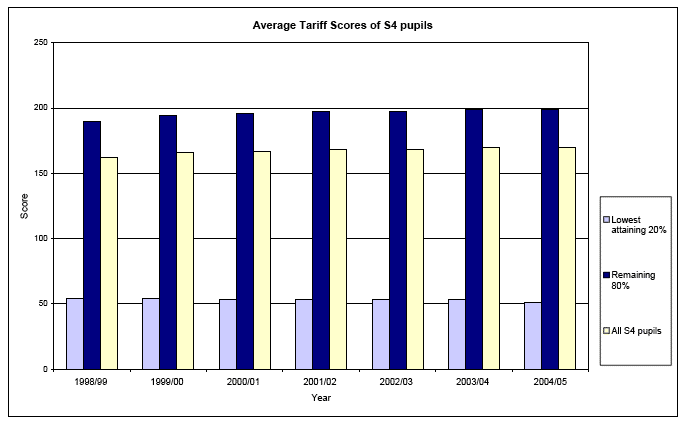
Source: Scottish Executive Education Statistics
Link
Closing the Opportunity Gap
Publication
SQA attainment and school leaver qualifications in Scotland: 2004/05 (Published 2006)
Destinations of School Leavers
Half of school leavers in 2004/05 went on to Further or Higher education. There was a 2 percentage point rise in the proportion of leavers going into Higher Education in 2004/05, whilst the proportion going into Further Education remained stable. Ten percent of school leavers are seeking employment or training in the autumn after leaving school.
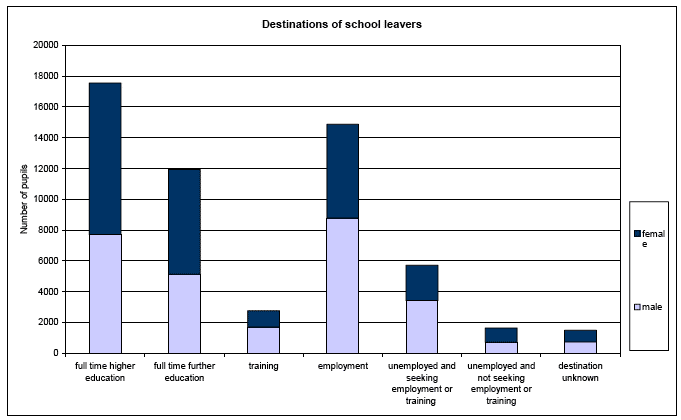
Source: Destination of Leavers from Scottish Schools
Publication
Destinations of Leaver from Scottish Schools: 2004/05 (Published 2005)
Schools
The School Estate
In 2005 there were 2,194 primary schools, 385 secondary schools and 190 special schools. Data from the first school estates survey in 2003 was incomplete, but 60% of respondents reported the condition of their school was satisfactory or good. The results of the 2004 survey suggested 57% of schools were in good or satisfactory condition, though there is some concern about the consistency of data collection between local authorities. Data was not collected in 2005.
Publications
Pupils in Scotland, 2005 (Published 2006)
School Estate Statistics, 2004 (Published 2005)
Class Sizes
In 2003 average class sizes were for S1/S2 Maths, 25.4 pupils; for S1/S2 English, 25.9 pupils.
Average primary class sizes by type of class and stage, 1998- 2005
Class Type |
1998 |
1999 |
2000 |
2001 |
2002 |
2003 |
2004 |
2005 |
|---|---|---|---|---|---|---|---|---|
All |
24.9 |
24.6 |
24.4 |
24.3 |
24.0 |
23.7 |
23.9 |
23.6 |
Single stage |
26.5 |
26.1 |
25.7 |
25.7 |
25.5 |
25.1 |
25.3 |
25.1 |
Composite |
20.7 |
20.6 |
20.5 |
20.6 |
20.2 |
20.1 |
20.2 |
19.9 |
Single stage classes by stage |
||||||||
P1 |
24.7 |
24.0 |
23.7 |
23.7 |
23.5 |
23.2 |
23.2 |
23.1 |
P2 |
26.3 |
25.4 |
25.0 |
24.8 |
24.6 |
24.3 |
24.6 |
24.2 |
P3 |
26.9 |
26.4 |
26.0 |
25.3 |
25.3 |
24.6 |
25.1 |
25.1 |
P4 |
27.3 |
27.0 |
26.6 |
26.5 |
26.3 |
25.9 |
26.1 |
26.0 |
P5 |
27.1 |
27.1 |
26.7 |
26.7 |
26.5 |
26.2 |
26.5 |
26.3 |
P6 |
26.8 |
26.7 |
26.7 |
26.7 |
26.6 |
26.3 |
26.2 |
26.2 |
P7 |
26.3 |
26.0 |
25.8 |
26.2 |
26.0 |
25.7 |
25.9 |
25.4 |
School Expenditure
Total gross revenue spend by local authorities on schools was £4,180 million in 2004/05, an increase of 8% on the previous year (5.7% in real terms).
Gross Revenue Expenditure on Education on Education (£ms)
Pre-school |
Primary |
Secondary |
Special |
Total (1) |
|
|---|---|---|---|---|---|
2002-03 |
213 |
1,300 |
1,473 |
354 |
3,533 |
2003-04 |
237 |
1,436 |
1,610 |
391 |
3,873 |
2004-05 |
259 |
1,533 |
1,723 |
435 |
4,180 |
(1) Includes expenditure by Local Authorities which cannot be apportioned to the stages of education.
Publication
Expenditure on school Education in Scotland, 2006 (Published 2006)
Teachers
Teacher Numbers
2005 figures show that the full-time equivalent number of school education staff were:
school-based teachers |
50,517 |
|---|---|
pre-school teachers |
1,662 |
visiting teachers |
1,452 |
classroom assistants |
5,414 |
other classroom staff |
8,529 |
non-classroom staff |
8,412 |
other LA based support staff |
2,396 |
Pupil teacher ratios have been improving since 1997.
Pupil teacher ratios
1997 |
2000 |
2001 |
2002 |
2003 |
2004 |
2005 |
|
|---|---|---|---|---|---|---|---|
Primary |
19.9 |
19.0 |
18.9 |
18.0 |
18.2 |
17.6 |
17.1 |
Secondary |
13.2 |
13 |
12.9 |
12.7 |
12.8 |
12.7 |
12.3 |
Special |
4.7 |
4.2 |
4.0 |
3.9 |
3.8 |
3.7 |
3.5 |
Publication
Teachers in Scotland, 2005 (Published 2006)
Teacher Workforce Planning
Teacher workforce planning is carried out annually to ensure adequate supply of teachers, up to 53,000 by 2007. The model takes into account falling pupil projections, rates of teachers leaving and joining the profession, drop out rates from university courses, etc.
A challenging increase in requirement for teacher training in 2004 was met, with the even greater increase in 2005 almost met. A similar level is required in 2006.
Numbers include requirements necessary for "McCrone" changes in class contact time.
Current and projected requirements for number of teachers in primary and secondary staff are shown in the charts below.
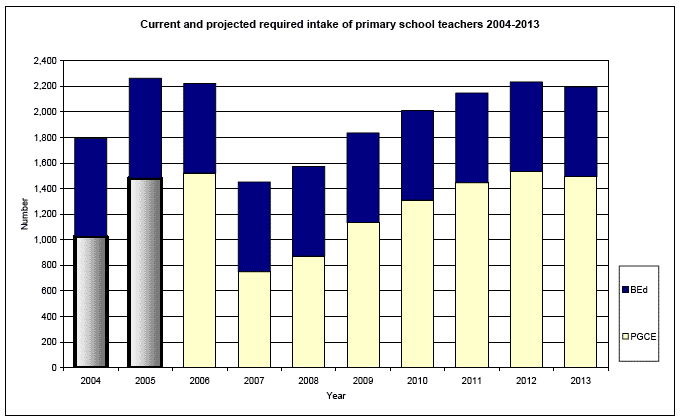
Source: Scottish Executive Education Statistics
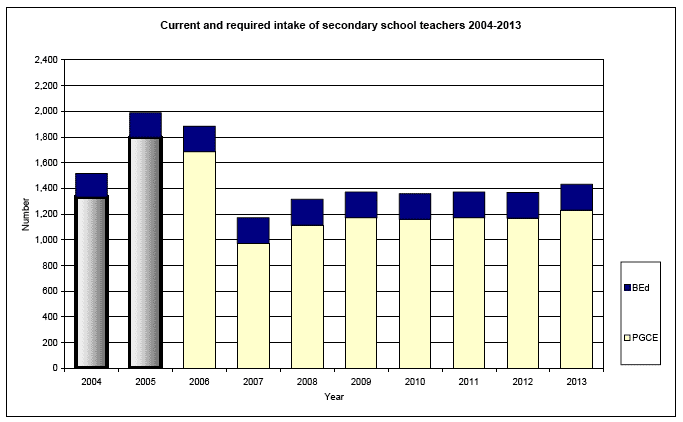
Source: Scottish Executive Education Statistics
Teacher Vacancies
Vacancy statistics show that generally there is not a shortage of teachers. However there are some difficulties in particular subject areas. Higher rates of vacancies are to be found in Gaelic medium, English and Modern Studies. In February 2005 there were just over 440 vacancies which had lasted over 3 months.
Publication
Teacher Vacancies and Probationer Allocations, 2005 (Published 2005)
Best Start for Children
School Nutrition
Of those entitled to free meals, 67% were present and took a free school meal in January 2005, a percentage which has declined slightly in recent years.
Amongst all pupils present on the survey day, 47% took a meal supplied by the school, a decrease from 51% in 2003 and 49% in 2004.
Anecdotal evidence suggests the introduction of cashless systems may have initially lowered uptake rates where pupils forget their swipe-card, as does the introduction of new menus.
A third of mainstream schools had an anonymised system for free school meals receipt, nearly every publicly funded primary schools gave free fresh fruit to P1 and P2 pupils and 94% of all schools had free fresh chilled water available to pupils and staff at all times .
Publication
School Meals in Scotland, January 2005 (Published 2005)
Schools Safety
Discipline
The 2004 teachers' perceptions data indicated that most indiscipline in school is low level but that this is regularly experienced by teachers, particularly in secondary school. Data below represent reports by teachers of behaviour that occurred at least once in their classrooms during a one week period:
- Pupil on pupil physical violence was reported by 56% of secondary teacher respondents, and 63% of primary teachers
- Pupil on teacher physical violence was reported by 8% of secondary teachers and 2% of primary teachers
- Pupil on pupil verbal abuse was reported by 79% of secondary teachers and 63% of primary teachers
- Pupil on teacher verbal abuse was reported by 45% of secondary teachers and 12% of primary teachers
- Pupil on pupil racist abuse was reported by 11% of secondary teachers and 4% of primary teachers
- Pupil on pupil sexist abuse was reported by 33% of secondary teachers and 12% of primary teachers
Publication
Discipline in Scottish Schools, 2004 (Published 2004)
School Attendance
During 2004/05 the total rate of absence for primary schools was 5.0%, authorised absence was 4.1%, unauthorised absence was 0.9%, temporary exclusions were 0.02%. The percentage attendance in primary schools by local authority ranged from 92.9% (Glasgow) to 96.4% (Scottish Borders).
The total rate of absence for secondary schools was 9.8%, authorised absence was 7.7%, unauthorised absence was 1.9% and temporary exclusions were 0.24%. The percentage attendance in secondary schools by local authority ranged from 86.6% (Glasgow) to 94.0% (East Renfrewshire).
In general, schools with higher levels of deprivation had higher levels of absence, although there were many schools which did not follow this trend. Reason for absences included; 2.8% of days lost due to sickness, 0.8% due to truancy and 0.5% due to holidays. Ten per cent of pupils are responsible for 90% of truancy.
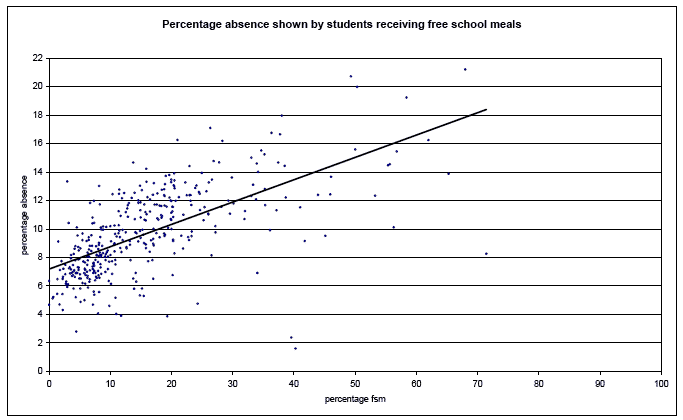
Source: Scottish Executive Education Statistics
Publication
Attendance and Absence in Scottish Schools, 2004/05 (Published 2005)
School Exclusions
During 2004/05 there were 41,974 exclusions from local authority schools in Scotland, an increase of 8% from 2003/04. In 271 cases, pupils were removed from the register of the school, though local authorities may also reach agreements with parents to move a pupil to another school without the use of a formal 'removal from register'
The increase may be related to the dropping of the target to reduce exclusions. Rates were highest in S3. Deprivation, educational needs, and "looked after by LA" were all issues linked to high rates.
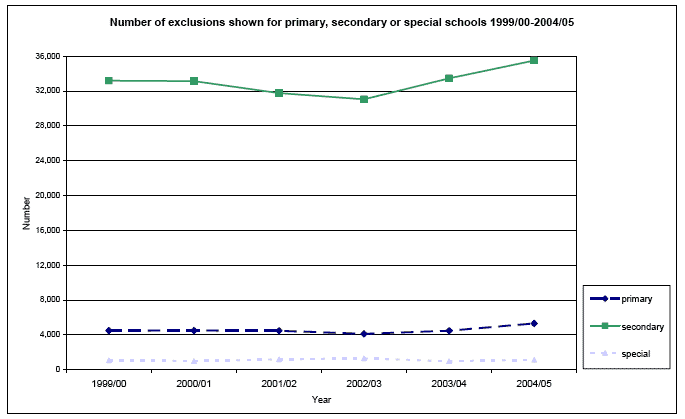
Source: Scottish Executive Education Statistics
Publication
Exclusions from Schools, 2004/05 (Published 2006)
School Inclusion
Special Educational Needs
In 2005 34,577 pupils (4.8%) have a Record of Needs or Individualised Educational Programme (6.7% of boys and 3.0% of girls). About a fifth of these have specific learning difficulties in language or maths (including dyslexia), or moderate learning difficulties and 27,540 (80% of them) are in mainstream schools. They make up 3.9% of mainstream school pupils.
All time in mainstream classes |
Some time in mainstream classes |
Mainstream school, but non-mainstream classes |
Special school |
|
|---|---|---|---|---|
2003 |
18,838 61% |
3,747 12% |
681 2% |
7,573 25% |
2004 |
20,999 64% |
3,612 11% |
752 2% |
7,242 22% |
2005 |
22,788 66% |
3,879 11% |
873 3% |
7,037 20% |
There has been an increase in number with autistic spectrum disorders (2,663 in special schools in 2003; 3,484 in 2005) which is usually ascribed to better identification and recognition of ASD.
Publication
Pupils in Scotland 2005 (Published 2006)
Modern Curriculum
Drug Education
The last annual survey on drug education found that in 2002/03, nearly every local authority primary and secondary school and 96% of local authority special schools were providing drug education.
Publication
Drug Education in Schools 2002/2003 (Published 2003)
Gaelic
The number of primary school pupils in Gaelic medium education in 2005/06 was 2,048, with a further 160 being taught Gaelic through the medium of Gaelic. In secondary there were 433 pupils receiving Garlic medium education, with a further 1,292 being taught Gaelic through the medium of Gaelic.
The number of school entries in 2004/05 for Higher grade Gaelic (learners) was 103; the same as last year. The number of school entries in 2004/05 for Higher grade Gaidhlig was 102, slightly higher than in the preceding two years
Music Tuition
There were 574 peripatetic music instructors recorded in the 2005 staff census as centrally employed, together with those attached to schools.
There is a problem
Thanks for your feedback